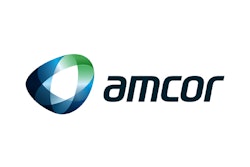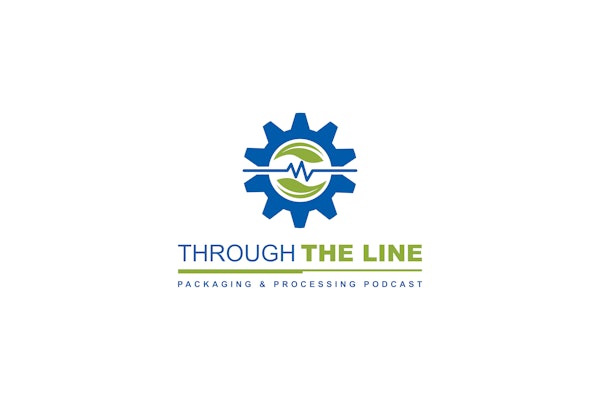
Another fiber-free winner
Also winning a DuPont award on the strength of its fiber-free peeling characteristics was a pouch made by Rexam Healthcare Flexibles for sterilizable medical products. The white opaque side of the pouch is an uncoated DuPont Tyvek. Heat-sealed to it is a clear 48-ga polyester that is coextrusion-coated with Rexam’s patented Core-Peel™ coating.
According to Rexam, the Core-Peel coating produces a pouch that, compared to alternative technologies:
• requires a more consistent opening force
• eliminates both coating and fiber particulates, which means a lot to medical personnel who are obsessed with cleanliness
• widens the processing window so that heat-sealing equipment doesn’t have to be so closely monitored
The pouch is compatible with radiation, ethylene oxide, or plasma sterilization. It will compete, says Rexam, wherever coated or uncoated Tyvek pouchs are currently used. No users of the award-winning pouch could be identified at press time.
Desiccant delivers
LifeScan Inc.’s Harmony INR blood monitoring test strips aren’t yet available for use by consumers, or at medical centers, but that didn’t stop the DuPont Awards judges from recognizing the individually packaged strips with a silver award in the non-food category.
Used by patients taking the prescription blood thinner Warfarin, each strip conducts three tests to measure the amount of Prothrombin in whole blood. Protecting the costly strips from moisture is the key barrier property delivered by each pouch. The film used for the pouch is converted by Pechiney Plastic Packaging. Limited quantities of pouches are filled and sealed by LifeScan on a 4SS side-sealing machine from Doyen Medipharm. LifeScan credits Thysen Consulting with coordinating the packaging design and specifications among the suppliers.
The 4.35-mil extrusion lamination includes 48-ga polyester/7# tie layer/35-ga aluminum foil/7# tie layer/2.5-mil desiccant sealant layer. Calcium oxide acts as the desiccating agent in the polyethylene sealant layer, helping to deliver moisture barrier of virtually 0 in the first 24 hours. The water vapor transmission rate is 0.0003 g/100 sq”/24 hr, according to Brian Earp, LifeScan’s senior market manager for new products and market development, who attributes the numbers to Pechiney testing. Pechiney reverse-prints the outer polyester layer in three colors on a gravure press.
Five of the packaged test strips (about a month’s worth) will be sold in a flexible carton, but not until stability testing is completed. The packaging materials are being tested by LifeScan, the Milpitas, CA-based cardiovascular business unit of Johnson & Johnson.
The goal is to have the new packaging available to consumers and clinics by October, says Earp.
“Any time you have a packaging change, you have to validate the stability, and we’re in that process,” he says. The new package will replace the high-density polyethylene bottle used currently, which has a twist cap that includes a molecular sieve desiccant.
The trouble with the bottle and cap, Earp believes, has more to do with human behavior than any fundamental material limitations. “Once you take the cap off, the strips are exposed to heat and humidity, and people may forget to put the cap back on, and the strips could expire,” he says. That wouldn’t be the case with an individually packaged strip.
LifeScan wanted foil to be part of the structure to replace the bottle and cap, so it contacted multiple foil providers, and consultants, to develop a structure that wouldn’t allow moisture ingress. “Pechiney had been looking at this in a research format and had come up with a product, but nobody had used it for a medical application,” Earp recalls. “We wanted to be the first to try this, but we had to take several things into consideration.”
Those included avoidance of pinholes, the need for materials to work on “standard” packaging equipment at reasonable line speeds, temperature and humidity in the packaging area, and 100% packaging verification.
Earp says, “We’ve been very happy with the material. There are two key things preventing the ingress of water. One is that the structure has seven layers to protect the product. And, even if you were to get a pinhole, the desiccant sealant barrier can absorb the water or humidity.” Shelf life, he says, is still under test, “but we project it will be longer” than the 18 months for the bottle and cap.
On top of all these benefits, Earp says the new pouch structure “has reduced our unit cost by at least 50 percent. We can fit 50 individually wrapped strips in the same-sized carton as we now use for five bottles.”
But what about the costs of buying new equipment to fill and seal the pouches? Justifying the equipment purchase “was the easiest part,” Earp says, due to labor costs associated with packing the bottle and cap. “This pack [allows us to] fully automate our packaging process and reduces our costs by 50 percent, if not more.
“The two biggest success factors [in this process] have been the help we’ve received from Pechiney and Doyen,” Earp relates. “They’ve both been great partners, letting us know where we might have problems and figuring out how to solve them, as opposed to just selling us material or equipment. Pechiney puts the film structure together and sends rollstock to Doyen. And Doyen gives us the option of buying their equipment and giving us the specifications for running the film on their equipment, or providing contract packaging services at their facility in Florida.”
Deft dispensing
For asthma sufferers, GlaxoSmithKline’s Advair Diskus disk-shape dispenser must be a breath of fresh air. It certainly impressed DuPont Awards judges, who honored it with a gold in the non-food category.
The international pharmaceutical giant introduced the dry powder inhalation device in the United States in April 2001. It is meant as an alternative to standard aerosol actuators. Since its launch, GSK says there have been 20 million prescriptions for Advair Diskus.
Currently, GSK uses the Diskus for its Serevent Diskus powder, though the company says that in the future it could be used for other pharmaceutical products.
Unlike some aerosol devices, there’s no need for the patient to hold the metered dose inhaler to his or her mouth and push down on a canister and inhale simultaneously to administer the proper dose. There’s no spacer device, either. To dispense medication, the patient actuates a lever. This causes the lidding material to be peeled away from the base material of a blister strip, exposing the powder-filled blister within the Advair Diskus device. The product is then inhaled by the patient through a manifold and a mouth piece.
Advair Diskus also incorporates a dose counter feature that counts down to zero to let the user know how many doses remain in the pack.
All together, the device includes 14 components injection-molded of polypropylene, acrylonitrile butadiene styrene, polycarbonate, and acetal, by Bespak. Bespak automatically pre-assembles 11 of these components to form the main sub-assembly. GSK assembles the remaining three components—the body top, mouth piece, and outer case. New, automated assembly equipment was developed by Sortimat for GSK and Bespak.
GSK blends the powdered medication and fills it into blister strips that it assembles into the device in either a 28-dose-count for samples, or 60 doses for trade sales. Filled strips are cut to length, coiled, then inserted into the device during assembly by GSK. A loop is formed on one end of the strip, a “dimple” on the other to secure it in the device. In the Diskus, the coiled strip is held within a manifold. The body top covers the filled sub-assembly. The mouthpiece used to inhale the medication, and an outer case, are the final components.
The forming web of the blister strip containing the powdered medication is cold-formed. From the outside-in, the forming web includes nylon/laminating adhesive/laminating primer/aluminum foil/laminating adhesive/polyvinyl chloride. Total thickness is approximately 7 mils. The base foil material is supplied by Alcan.
Alcan also supplies lidding rollstock. The approximately 4-mil material, from the outside in, includes bleached satined sulphate paper/laminating adhesive/biaxially oriented polyester/laminating adhesive/aluminum foil/heat-seal lacquer.
For additional protection, the Diskus is overwrapped in a sealed pouch that includes polyester/low-density polyethylene adhesive/soft-tempered aluminum foil/ethylene butylacrylate maleicandhydride terpolymer/LDPE adhesive/LDPE.
Flexa Tube
Winning gold in the non-food category was the Flexa Tube from Graham Packaging. It’s a one-piece tube formed by extrusion blow molding and designed to dispense food or cosmetics products.
What makes it special is its retractable dome, which withdraws entirely within the tube body. Once it’s retracted, the tube stands perfectly on end, just as if it were capped with a conventional injection-molded overcap. By obviating the need for a separate overcap, the Flexa Tube is said to be a cost saver.
To dispense the contents of the tube, the consumer squeezes the body. This causes the retracted dome to emerge. All that’s left is to remove the threaded injection-molded low-density polyethylene closure and squeeze. The consumer can then leave the dome out and store the tube on its side or push the dome back inside the body to store the tube vertically.
The 80-mL (2.71-oz) Unilever shampoo product shown here is sold in South America. Unilever could not be reached for comment, but according to Graham the Sedal tube weighs 9.5 g, has an 18-mm threaded closure, and is decorated with a pressure-sensitive label. Direct printing on the tube is also a decorating option, says Graham. Another option is a multilayer construction should barrier requirements call for it.
Pump it up
In the protective packaging department, Sealed Air’s Inflatable Bubble Wrap™ packaging system won a silver award in the non-food category. The system automatically inflates and dispenses perforated, ¾”-high Inflatable Bubble Wrap material.
Because it creates cushioning material on demand, this new packaging system significantly reduces the amount of space needed to store packaging materials, says Sealed Air. The firm estimates that 32 uninflated rolls of Inflatable Bubble Wrap cushioning occupy about the same space as a tractor trailer full of traditional cushioning materials.
In addition, Sealed Air points out that the ¾” bubble is ¼” larger than the largest bubble height available today. The added height provides extra cushioning protection and may permit customers to use up to 25% less material to wrap the same item. The Inflatable Bubble Wrap system, which plugs into a standard 110-v outlet and does not require shop air, is completely portable.
Water-soluble winner
Winning a gold award for MonoSol LLC was that firm’s water-soluble polyvinyl alcohol film. Packaging products in water-soluble film, says MonoSol, allows companies to give consumers a premeasured unit dose of a product that is convenient and that dissolves completely, leaving no trace of packaging requiring disposal. Depending on the material inside the package, water-soluble films can also enhance safety by eliminating direct contact between the user and the product.
Though no specific users of MonoSol’s award-winning film could be identified at press time, the detergent pouches shown here represent a typical application. MonoSol takes PVOH resin supplied by DuPont and makes film by means of a process that it calls “solution casting.” The film is then run through conventional f/f/s or, in some cases, thermoforming systems.
































